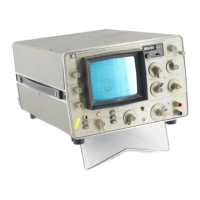Model 3580A
GENERAL
OPERATING
INFORMATION
Section III
3-165. X-Axis Output. The
X-AXIS
output supplies a
de
voltage proportional to the position
of
the frequency sweep
on the CRT display.
When
the sweep
is
at the start
frequency, the
X-Axis
output
is
0 V de; when the sweep
is
at the end frequency, the output
is
+ 5 V de. The output
resistance
is
1 Kilohm, nominal.
3-166. In the Repetitive and Single sweep modes when
Adaptive Sweep
is
not used, the
X-Axis
output
is
a 0 V to
+ 5 V linear ramp.
When
Adaptive Sweep
is
used, the
output voltage tracks the forward and reverse excursions of
the sweep.
In
the Manual sweep mode, the
X-Axis
output
voltage corresponds to the sweep position set by the
MANUAL VERNIER control.
When
the Reset or
Log
Zero
mode
is
selected, the
X-Axis
output remains at 0 V de.
3-167. In the
Log
sweep mode, the frequency
is
swept
logarithmically but the
X-Axis
output
is
still a 0 V to + 5 V
linear ramp.
An
output
of
0 V
de
corresponds to the 20
Hz
start frequency,
an
output
of
+ 2.5 V
de
corresponds to
982
Hz
at the center
of
the display and an output
of+
5 V
de
corresponds
to
the 43 kHz end frequency.
NOTE
Because
of
the relatively fast sweep rates used
in
the Log sweep mode, conventional
X-Y
recorders connected to the X-AXIS
output
cannot respond properly.
To
make amplitude
vs.
log-frequency recordings, use
an
X-Y
record-
er
that has a built-in log converter for the
X-axis input (-hp- 7035B Opt. 020). Connect
the 3580A X-AXIS output to the X-axis input
of
the recorder.
With
the recorder set to the log
mode, sweep the 3580A at a slow linear rate
using the Single or Repetitive sweep mode.
3-168. V-Axis Output. The Y-AXIS output supplies a
de
voltage proportional to the amplitude
of
the responses
appearing on the display. An output
of
0 V de corresponds
to
the bottom
of
the screen; an output
of
+ 5 V
de
corresponds to the top
of
the screen. The Y-Axis output
voltage
is
0.5 V per division in the Linear amplitude mode,
0.05 V per
dB
in the
Log
10
dB
mode and 0.5 V per
dB
in
the Log 1
dB
mode. Output resistance
is
1 kilohm nomi-
nal.
3-169. There are several things about the Y-AXIS output
that should be noted:
a.
In the Log 10
dB
mode, rotating the AMPLITUDE
REF LEVEL control
in
a clockwise direction offsets the
display in steps
of
10 dB. This also offsets the Y-Axis
output in steps
of+
0.5 V.
b. In the
Log
1
dB
mode, the display ranges from 0
dB
(+
5 V)
to
-10
dB
(0 V). The
Y-Axis
output, however,
extends from approximately + 1
dB
(+ 5.5 V) to - 13
dB
(-1.5 V).
c.
Changing the baseline threshold using the
ADAP-
TIVE
SWEEP
control does not effect the
Y-Axis
output
voltage.
3-170.
Pen
Lift Output. The
PEN
LIFT output
is
provid-
ed
for
use
with
X-Y
recorders having electrically operated
pen lift circuits that allow the pen to be remotely actuated
by a contact closure. The
PEN
LIFT output
is
operative
only in the Single sweep mode.
If
Adaptive Sweep
is
not
used, a contact closure
is
present between the
PEN
LIFT
output terminals for the duration of the single sweep.
If
Adaptive Sweep
is
used, the contact closure
is
present only
when the instrument
is
sweeping slowly over a response.
This prevents the fast-forward and fast-backward excur-
sions
of
the sweep from being recorded. The PEN LIFT
output terminals
are
isolated from
case
ground.
Do
not
use
clear-write to reset sweep.
3-171.
Tracking
0
scillator
Output.
3-172. The rear panel TRACKING
OSC
OUT connector
supplies a 5
Hz
to 50
kHz
sinusodial output
signal
that
tracks the tuned or swept frequency
of
the instrument.
The specified frequency response
of
the tracking oscillator
output
signal
is
±
3%
over the 5
Hz
to 50
kHz
frequency
range. Total harmonic distortion and spurious
is
more than
40
dB
below a 1 V
rms
signal level. The output impedance
is
600 ohms, nominal.
When
the output
is
terminated
in
600 ohms, the LEVEL control may be used to adjust the
output from 0 V to 1 V rms.
3-173. The frequency accuracy
of
the tracking oscillator
output
signal
is
specified at ± 2.5
Hz
relative to the center
of
the instrument's passband.
On
the 1
Hz
and 3 Hz
bandwidtns, the passband
is
less
than 2.5
Hz
above and
below the center frequency. Thus, the tracking oscillator
output frequency may be slightly outside
of
the passband.
This
is
of
little consequence except during closed-loop
measurements where the tracking oscillator signal
is
fed
into the INPUT through a network under test.
If
the
tracking oscillator frequency
is
outside the passband, inser-
tion loss
will
be
encountered. Under worst
case
conditions,
maximum insertion loss
is
approximately 30
dB
on the 1 Hz
bandwidth and 8
dB
on the 3
Hz
bandwidth. Typically, the
insertion
loss
is
about 5
dB
on
the 1
Hz
bandwidth and 2
dB
on the 3 Hz bandwidth.
3-174. For most closed-loop measurements optimum
re-
sults
will
be
obtained using the 10
Hz
or 30
Hz
bandwidth.
If, for some reason, the 1
Hz
or 3
Hz
bandwidth
is
used,
insertion loss can
be
minimized by removing the top cover
and adjusting A2C4 (100 kHz ADJ)
so
that the tracking
oscillator frequency
is
in the center
of
the passband,
An
alternative approach
is
to apply
an
external reference
signal
to the TRACKING
OSC
IN
connector and adjust the
frequency
of
the reference
so
that the tracking oscillator
frequency
is
in the center
of
the passband
(see
Paragraph
3-176).
3-23

